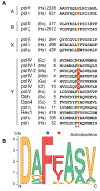Ribonucleotide discrimination by translesion synthesis DNA polymerases
- PMID: 29972306
- PMCID: PMC6261451
- DOI: 10.1080/10409238.2018.1483889
Ribonucleotide discrimination by translesion synthesis DNA polymerases
Abstract
The well-being of all living organisms relies on the accurate duplication of their genomes. This is usually achieved by highly elaborate replicase complexes which ensure that this task is accomplished timely and efficiently. However, cells often must resort to the help of various additional "specialized" DNA polymerases that gain access to genomic DNA when replication fork progression is hindered. One such specialized polymerase family consists of the so-called "translesion synthesis" (TLS) polymerases; enzymes that have evolved to replicate damaged DNA. To fulfill their main cellular mission, TLS polymerases often must sacrifice precision when selecting nucleotide substrates. Low base-substitution fidelity is a well-documented inherent property of these enzymes. However, incorrect nucleotide substrates are not only those which do not comply with Watson-Crick base complementarity, but also those whose sugar moiety is incorrect. Does relaxed base-selectivity automatically mean that the TLS polymerases are unable to efficiently discriminate between ribonucleoside triphosphates and deoxyribonucleoside triphosphates that differ by only a single atom? Which strategies do TLS polymerases employ to select suitable nucleotide substrates? In this review, we will collate and summarize data accumulated over the past decade from biochemical and structural studies, which aim to answer these questions.
Keywords: DNA polymerase; mutant polymerases; replicative bypass; ribonucleotide incorporation; steric gate; translesion DNA synthesis.
Figures




Similar articles
-
The steric gate of DNA polymerase ι regulates ribonucleotide incorporation and deoxyribonucleotide fidelity.J Biol Chem. 2014 Mar 28;289(13):9136-45. doi: 10.1074/jbc.M113.545442. Epub 2014 Feb 14. J Biol Chem. 2014. PMID: 24532793 Free PMC article.
-
An error-prone family Y DNA polymerase (DinB homolog from Sulfolobus solfataricus) uses a 'steric gate' residue for discrimination against ribonucleotides.Nucleic Acids Res. 2003 Jul 15;31(14):4129-37. doi: 10.1093/nar/gkg417. Nucleic Acids Res. 2003. PMID: 12853630 Free PMC article.
-
Unlocking the steric gate of DNA polymerase η leads to increased genomic instability in Saccharomyces cerevisiae.DNA Repair (Amst). 2015 Nov;35:1-12. doi: 10.1016/j.dnarep.2015.07.002. Epub 2015 Aug 7. DNA Repair (Amst). 2015. PMID: 26340535 Free PMC article.
-
[The presence of ribonucleotides in DNA has an ambiguous impact on the maintenance of genetic stability].Postepy Biochem. 2019 Jun 6;65(2):143-152. doi: 10.18388/pb.2019_247. Postepy Biochem. 2019. PMID: 31642653 Review. Polish.
-
Translesion DNA polymerases in eukaryotes: what makes them tick?Crit Rev Biochem Mol Biol. 2017 Jun;52(3):274-303. doi: 10.1080/10409238.2017.1291576. Epub 2017 Mar 9. Crit Rev Biochem Mol Biol. 2017. PMID: 28279077 Free PMC article. Review.
Cited by
-
Novel Escherichia coli active site dnaE alleles with altered base and sugar selectivity.Mol Microbiol. 2021 Sep;116(3):909-925. doi: 10.1111/mmi.14779. Epub 2021 Jul 31. Mol Microbiol. 2021. PMID: 34181784 Free PMC article.
-
Ultraviolet-induced RNA:DNA hybrids interfere with chromosomal DNA synthesis.Nucleic Acids Res. 2021 Apr 19;49(7):3888-3906. doi: 10.1093/nar/gkab147. Nucleic Acids Res. 2021. PMID: 33693789 Free PMC article.
-
RNA polymerase drives ribonucleotide excision DNA repair in E. coli.Cell. 2023 May 25;186(11):2425-2437.e21. doi: 10.1016/j.cell.2023.04.029. Epub 2023 May 16. Cell. 2023. PMID: 37196657 Free PMC article.
-
Mimivirus encodes a multifunctional primase with DNA/RNA polymerase, terminal transferase and translesion synthesis activities.Nucleic Acids Res. 2019 Jul 26;47(13):6932-6945. doi: 10.1093/nar/gkz236. Nucleic Acids Res. 2019. PMID: 31001622 Free PMC article.
-
The Impact of RNA-DNA Hybrids on Genome Integrity in Bacteria.Annu Rev Microbiol. 2022 Sep 8;76:461-480. doi: 10.1146/annurev-micro-102521-014450. Epub 2022 Jun 2. Annu Rev Microbiol. 2022. PMID: 35655343 Free PMC article. Review.
References
-
- Bassett E, Vaisman A, Tropea KA et al. (2002). Frameshifts and deletions during in vitro translesion synthesis past Pt-DNA adducts by DNA polymerases β and η. DNA Repair 1:1003–16. - PubMed
-
- Belousova EA, Maga G, Fan Y et al. (2010). DNA polymerases β and λ bypass thymine glycol in gapped DNA structures. Biochemistry 49:4695–704. - PubMed
Publication types
MeSH terms
Substances
Grants and funding
LinkOut - more resources
Full Text Sources
Other Literature Sources
Miscellaneous
